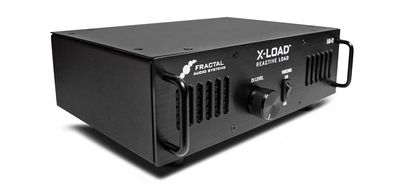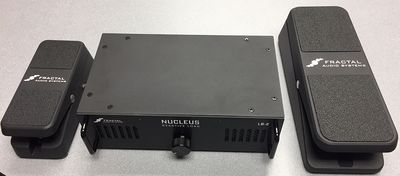August 2025: pages F-Z have been reviewed. Pages A-E are next
Difference between revisions of "X-Load Reactive Load LB-2"
| Line 66: | Line 66: | ||
* Connect the other 4 ohm output to the LB-2 Amp In jack. | * Connect the other 4 ohm output to the LB-2 Amp In jack. | ||
| − | This will present two 8-ohm loads in parallel to your amp which is equivalent to a 4-ohm load. Half of your amp’s output power will go the speaker and the other half into the LB-2 reducing the volume of your amp by 6 dB. You can also use the DI features of the LB-2 in this configuration. | + | This will present two 8-ohm loads in parallel to your amp, which is equivalent to a 4-ohm load. Half of your amp’s output power will go the speaker, and the other half into the LB-2 reducing the volume of your amp by 6 dB. You can also use the DI features of the LB-2 in this configuration. |
The X-Load can be used for [[IR Capture]]. | The X-Load can be used for [[IR Capture]]. | ||
Revision as of 14:44, 17 July 2018
Contents
About the X-Load LB-1
The LB-1 has not yet been released by Fractal Audio.
"The LB-1 will be a load box with integrated IR player." source
"There are two models. The LB-1 is a full-featured product that includes stereo IR processing plus effects and a whole lot more (I don't want to spill the beans yet)." source
About the X-Load LB-2
Product information:
"The LB-2 is a passive load box that replicates the complex impedance of a guitar loudspeaker. It features our Dynamic Impedance Technology, which delivers unprecedented realism by dynamically changing the impedence of the load depending on the power levels of the connected amplifier."
"The X-Load LB-2 Load Box represents the pinnacle of speaker emulation technology for live use or recording. It allows you to use a traditional tube amp without connecting a speaker cabinet. The X-Load LB-2 provides an 8Ω load (100W maximum) while outputting a balanced or unbalanced line level signal.
Unlike other load boxes and attenuators the X-Load LB-2 uses Fractal Audio Systems' Dynamic Impedance technology to create a level of realism never achievable before. Record your amp in its sweet spot without deafening volume, or get great tone consistently without the hassles of a speaker cab and microphone setup.
It is important to note that the X-Load LB-2 does NOT simulate the characteristic sound of a loudspeaker. This is done by routing your DI Amp signal through speaker simulation hardware—like that found in our award-winning Axe-Fx or AX8 products—or software, like our Cab-Lab application/plugin.
The X-Load LB-2 features a Speaker Thru jack so you can connect a real speaker while also feeding line signal to a recorder or speaker simulator.
The Voicing switch shifts the resonance of the load. The “UK” setting is characteristic of the typical British guitar speaker, while the “US” position replicate the lower resonance of a typical American guitar speakers.”
"The idea is that you use this with any of our products that have cab modeling (Axe-Fx, AX-8, Cab-Lab). Some people refuse to use modelers so this is a product for them." source
"The load itself uses proprietary, custom-designed magnetics that mimic the dynamic impedance of an actual loudspeaker. I've been testing the passive version and it sounds much better than any other loadbox I've tried. No high end loss and nice, chunky bass response." source
"The impedance of our load actually resembles a real speaker. The same can't be said about some of the other so-called "reactive loads". Furthermore I've developed proprietary magnetics technology so the impedance changes with applied voltage, like a real speaker does. Most importantly though, it sounds really good. I'd go so far to say it sounds better than when I use my iso cab as a load.” source
"A real speaker resembles a 4th-order network, at a minimum. Our load is 4th-order." source
"It's just a load box. There are several others on the market: Suhr, Torpedo Captor, etc. Ours sounds really good. I haven't tried the others so I can't comment but Suhr makes good stuff so I don't doubt their's sounds good. You can use the load box with any product that does speaker emulation including our Axe-Fx, AX-8 and Cab-Lab products or other products (like plug-ins) allowing you to record your favorite amp without the noise and hassles of micing a speaker. Furthermore this allows you to record a DI that you can reprocess later using different IRs. While the frequency response of a speaker to a voltage excitation is very linear and can be accurately captured by an IR, the various parameters of a speaker change with applied power. First of all the voice coil heats up and as a result it's resistance increases [1]. Secondly the equivalent inductance of the voice coil and the resonance frequency of the speaker change with excursion (see Dodd, Klippel, et. al.). Our load recreates these parameter changes that occur with excitation level using proprietary magnetic components (not magnets) which are made in USA." source
"The LB-2 is about 50/50 foreign and domestic content." source
Warnings!
Warning: The LB-2 is an 8 ohm device. Be sure to connect its Amp In jack to the proper output on your amplifier to avoid damage. Mismatching impedance can result in damage to your amp.
Warning: The maximum power rating of the LB-2 is 100W. Do not connect the LB-2 to any amplifier that is rated greater than 100W as this can damage the unit and/or the amp.
How to use the X-Load LB-2
As a silent load box and DI
- Connect your amplifier’s 8-ohm output to the Amp In jack at the rear of the LB-2.
- Connect either the Unbalanced or Balanced DI output to your audio interface or hardware cabinet emulator.
As a DI with a guitar speaker
- Connect your amplifier’s speaker output to the Amp In jack at the rear of the LB-2.
- Connect a speaker to the rear panel Speaker Thru jack.
- Connect either the Unbalanced or Balanced DI output to your audio interface or hardware cabinet emulator.
As an attenuator
The LB-2 can be used to reduce the volume of your amp by diverting half the power into its load.
- Connect one 4 ohm output of your amp to an 8-ohm speaker.
- Connect the other 4 ohm output to the LB-2 Amp In jack.
This will present two 8-ohm loads in parallel to your amp, which is equivalent to a 4-ohm load. Half of your amp’s output power will go the speaker, and the other half into the LB-2 reducing the volume of your amp by 6 dB. You can also use the DI features of the LB-2 in this configuration.
The X-Load can be used for IR Capture.
“You can use our reactive load as an attenuator by running your amp at 4 ohms. Plug your speaker into one jack and the load into the other. Half the amp's power will go to the speaker and the other half to the load. Not a huge reduction in volume but might tame things enough so you don't piss of your neighbor/wife/GF/mother-in-law/etc.” source
Controls on the LB-2
Front panel
DI LEVEL - This controls the DI output volume of the LB-2 at both the Unbalanced 1/4” and Balanced XLR jacks. Set this knob as required so as not to overdrive the input of a device connected to the DI Output of the LB-2.
VOICING - A tube amp interacts differently with different types of speakers. The voicing switch of the LB-2 changes the resonance of its load to simulate this.
- The “UK” position simulates a classic British guitar speaker.
- The “US” position lowers the resonance frequency to replicate the experience of playing through a classic American guitar speaker.
Rear panel
AMP IN - Connect the speaker output of your tube amp to this jack. The X-Load LB-2 is an 8-ohm (8Ω) device with a maximum power rating of 100W.
SPEAKER THRU - Connecting a speaker to this output jack disconnects the internal load and connects the Amp In jack to the speaker instead. The DI output will still be active, so you can simultaneously record or process the DI signal while using your amp with a real speaker.
UNBALANCED DI/LINE OUTPUT (1/4”) - This passive DI output provides a line-level signal.
BALANCED DI/LINE OUTPUT (XLR) - This active DI output provides a line level signal. For long cable lengths and maximum delity the XLR output is preferred as it provides a low- impedance output and immunity to noise conduction. This output requires that the X-Load LB-2 be powered in one of two ways:
- Connect an external power supply to the power input jack of the X-Load LB-2. Use a 9–24 VDC, center negative power supply (as typically used with “stomp boxes”).
- Supply phantom power via the connected XLR cable.
GROUND LIFT - This switch disconnects the ground of the X-Load LB-2 from the ground of the XLR output. This may help in breaking noisy ground loops.
WARNING: Never connect Speaker Thru to any mic, instrument or line-level inputs!
"If your XLR has phantom power you don't need a wall-wart. The active outputs provide a low-impedance buffered output without the coloration (and cost) of a transformer." source
Speaker
For maximum versatility, the LB-2 can be used WITH or WITHOUT a connected speaker. This allows you to use a speaker simulator for recording or front-of-house, while operating either silently or at normal levels.
The LB-2 does NOT emulate the sound of a loudspeaker. It outputs a line-level version of the signal your amplifier normally sends to a connected speaker. This must be processed to sound as if it has been through a speaker and microphone, typically using software like Fractal Audio Cab-Lab or a hardware solution like the Fractal Audio Axe-Fx II or III, AX8, or 3rd-party “speaker simulator” products.
Comparing its size to the EV pedals
More information
Forum discussions:
Videos:



